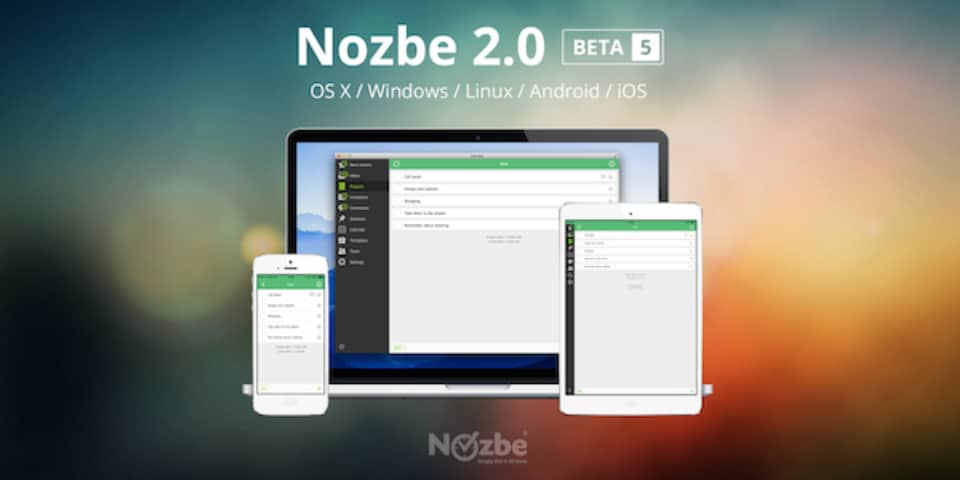

There isn’t a big learning curve, especially if you use getting started material such as mentioned below. I organize and find stuff by tagging and searching.
USE NOZBE TO SAVE EVERNOTE SOFTWARE
Many software programs such as web browsers, Outlook and Mindjet have Evernote add-ins, which makes moving content to Evernote fast and easy.īased on advice I found by Googling, I have only a few notebooks (“Todo” and “Reference”). You can search for tags or text in specific notebooks or across notebooks. If you search all notebooks for a tag, the resultant notes with that tag come up across notebooks. The main unit of Evernote is a “note.” Notes can be text, PDFs, photos, videos, audio, and they can have file attachments. The point is for Evernote to be really useful, it needs to become all encompassing for some universe of content. If you prefer to start slowly, you could create a notebook for one project, and have everything having to do with that project in an Evernote notebook. Above is a screen shot of Evernote on my PC. So, I have two Evernote “notebooks”, one for reference material and another for my todo’s and projects. Basically, it is a blank slate system that allows you to put all your stuff in one place for easy access. However, I never quite got how it worked and what I would use it for. You Have to Commit to Evernote for Evernote to be Useful If you are interested in learning about Evernote, even if you don’t use Getting Things Done, here are some tips to get you started. I’ve gone ahead and started using Evernote and am quite pleased. My column ends with the above tease about Evernote. For flexibility, comprehensiveness, support, cost, multi-device capability, and synchronization, Evernote (free) may well be the best choice.
USE NOZBE TO SAVE EVERNOTE PRO
Pocket Informant Pro ($14.99) and MyLifeOrganized ($9.99 iPad version $19.99), and particularly Nozbe (free), and Toodledoo ($2.99) were mentioned frequently. For those of us who also use a PC, there are several other alternatives.

I don’t want to wait, so I did quite a bit of research online for the best alternative.įor Mac, iPhone, and iPad users, the consensus seems to be the OmniFocus app ($19.99 iPad version: $39.99), or possibly Evernote (free). Cost and release date have not been announced.

Accordingly, the David Allen Company has teamed up with Intentional Software to develop GTD software from the ground up (/overview/gtd). According to online blogs and discussion, these tools can be quite helpful, but they also display some areas of clunkiness. There are literally hundreds of apps people use for GTD. Perhaps because GTD is systematic and algorithmic, it seems to attract technologically inclined individuals. The image to the left shows Evernote on the iPhone. The challenge is finding the right software. If your trusted system is in the cloud, you could access the same data on your iPad, PC, or Mac. The iPhone is the perfect tool for GTD-you can input, organize, and review tasks at any time. The key point is that most of our stuff sticks around in our inbox, desks, and minds because we don't take 10-15 seconds to clearly identify what each piece is. Organizing your tasks with the GTD system requires that you examine each item and quickly determine what to do with it: delete it, delegate it, defer it, file it, do it if it takes less than two minutes, or put it into a next action, someday, or projects list. You can review the system as often as necessary and determine the next action steps. With GTD, each item is either dealt with immediately, or clarified and placed in a trusted system nothing gets lost or overlooked. To do so, one must gather everything-thoughts, emails, papers, and reminders-that has no place to go. The goal of GTD is to get stuff out of your head and into a trusted system, so you can have a clear mind present on the task at hand. I do it so I can, as Allen says, “have a mind like water,” which refers to the state of readiness of a still pond that responds precisely to the force and mass of a pebble-neither overreacting nor under reacting-before returning to stillness. I am recommitting to using Allen’s proven methodology, making optimal use of my iPhone, iPad, and PC. However, as Allen would say, I have, fallen off the wagon. Some years back, when I ran this publishing company, I integrated David Allen's Getting Things Done® system into my daily routine. Everything seems to compete for my attention - daily email, voicemail, family obligations, ongoing projects, potential projects, consulting work, meetings, shopping, civic responsibilities, social media, apps to test, books to read, and a messy desk with piles of stuff.


 0 kommentar(er)
0 kommentar(er)
